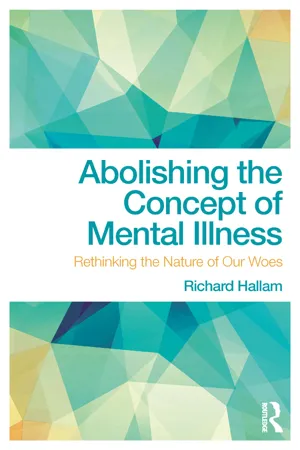Characteristics of Mental Health
The characteristics of mental health include emotional resilience, the ability to form and maintain positive relationships, a sense of purpose and meaning in life, the ability to cope with stress, and the capacity to adapt to change and uncertainty. Mental health also involves self-acceptance, a realistic perception of oneself and others, and the ability to manage one's emotions effectively.
4 Key excerpts on "Characteristics of Mental Health"
- eBook - ePub
- Michael Argyle(Author)
- 2013(Publication Date)
- Routledge(Publisher)
...Chapter 10 Mental Health What is Mental Health? The simplest definition of mental health is that it is the absence of anxiety, depression or other symptoms commonly found in mental patients. A definition of positive mental health has been suggested by Marie Jahoda (1958) as success or adaptation in the areas of love, work, play, interpersonal relations, situational requirements, ability to adapt and problem-solving. It is possible to make some assessment of mental health in the population by one question: ‘Did you experience unpleasant emotional strain yesterday?’ In a recent British survey the extent of such distress was as follows: % All of the time 4 Most of the time 5 About half the time 4 Some of the time 7 Just a little of the time 13 Not at all 65 Source: Warr and Payne, 1982 Psychological distress consists of negative emotions and related conditions: depression, anxiety and worry; minor physical symptoms such as headaches, sleeplessness and exhaustion; feelings of personal inadequacy, or of impending nervous breakdown. There is extensive evidence that such feelings are found in the same individuals, and that this forms a ‘general factor’ of personality. This general factor corresponds to the ‘neuroticism’ factor of the Eysenck Personality Questionnaire, and is also measured by the General Health Questionnaire (GHQ), both of which have been widely used in research...
- eBook - ePub
Mental Health and Wellbeing in the Workplace
A Practical Guide for Employers and Employees
- Gill Hasson, Donna Butler(Authors)
- 2020(Publication Date)
- Capstone(Publisher)
...1 Understanding Mental Health and Wellbeing Defining Mental Health and Wellbeing The World Health Organization (WHO) defines mental health as: ‘A state of well-being in which every individual realizes his or her own potential, can cope with the normal stresses of life, can work productively and fruitfully and is able to make a contribution to her or his community’. Our mental health affects the way we experience the world; how we think, feel, and behave towards ourselves and others. WHO defines mental health as a ‘state of well-being’ and just as physical health is intrinsic to wellbeing, so is mental health. The mental health organization ‘Mind’ suggests that if you have good mental wellbeing you are able to: feel relatively confident in yourself and have positive self-esteem feel and express a range of emotions build and maintain good relationships with others feel engaged with the world around you live and work productively deal with the stresses of daily life adapt and manage in times of change and uncertainty. Both Mind and the World Health Organization's definition of mental health refer to a person's wellbeing. But is wellbeing the same as wellness? When you think about wellness, think prevention and health. When you think about well-being, think happiness. Susie Ellis. Chair of the Global Wellbeing Institute Certainly, happiness is important, but there is more to wellbeing than the positive feelings that come with happiness. Both WHO and Mind recognize that wellbeing involves not just happiness, but crucially, the ability to manage difficulties, problems, and challenges; the ‘normal stresses’. In 2012, Cardiff Metropolitan University Professors Rachel Dodge and Annette P. Daly et al. published their report The Challenge of Defining Wellbeing...
- eBook - ePub
Abolishing the Concept of Mental Illness
Rethinking the Nature of Our Woes
- Richard Hallam(Author)
- 2018(Publication Date)
- Routledge(Publisher)
...it is integrated in the sense of providing continuity and consistency of meaning for self and others (see above). (4) A person is able to satisfy their needs but also shows a capacity for adaptation and adjustment when required to do so. (5) A person is motivated in the direction of growth or development – i.e. involved in new pursuits in order to expand their potential. (6) A person is self-determining in the sense of following their own chosen standards and is capable of acting relatively independently of others. Jahoda’s analysis of positive mental health is consistent with the Aristotelian concept of eudaimonia, and is distinct from hedonia that refers to the quality of feeling states (Ryan and Deci, 2001). The principles she extracts are very general in nature and they do not rule out the possibility (or inevitability) of conflicting urges and moral dilemmas. In practice, the principles have to be reconciled with a person’s philosophy, sense of spirituality, and their aesthetic, moral, and political values. Not all dilemmas can be resolved, and so, on these grounds, positive mental health is not always achievable. Negative feeling states such as depressed mood, anxiety, frustration, or discontentment can be interpreted, not as mental disorders, but as stages that are necessary in moving forward towards a more satisfactory (eudaimonic) form of self-expression. Ryff and Singer elaborate their interpretation of a eudaimonic approach to well-being and summarise findings that relate to their Personal Wellbeing Scale. Their five principles are self-acceptance, positive relations with others, personal growth, purpose in life, and environmental mastery. Like Jahoda, their position is that well-being can only be understood with reference to a person (or their ‘self’) in a social context...
- eBook - ePub
- Mary Atkinson, Garry Hornby(Authors)
- 2015(Publication Date)
- Routledge(Publisher)
...An important key to promoting children’s mental health is a greater understanding of the protective factors that result in some children being more resilient than others. Factors that protect children against mental health problems also include individual factors, such as being more intelligent and having an easy temperament, family factors, such as good relationships with parents and an educationally supportive family, and environmental factors, such as a good support network and positive school experiences (Mental Health Foundation, 1999). The more protective factors the child experiences the greater the likelihood of mental wellbeing. There is a complex interaction between the range of risk factors, their interaction with each other and with any protective factors, and this relationship is not clearly understood. However, children’s risk is greatly increased when adverse environmental circumstances, adverse family relationships and their personal characteristics reinforce each other. Research clearly suggests that as the disadvantages and the number of stressful circumstances accumulate, more protective factors are needed to compensate for this. Whilst biological factors may predispose children to some types of mental health difficulties, social circumstances, such as unemployment, divorce and stressful life events, and educational factors, such as their achievement and the school environment, are an important influence. An understanding of the main influences on children’s mental health can lead to effective treatment measures at child, family and environmental levels. There is also considerable correlation between these influences and later mental health difficulties, poor education outcomes and antisocial behaviour...



